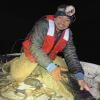Your HydroMoth experience!
29 July 2022 1:38pm
1 May 2024 5:51pm
Hey! I would recommend a few things:
1) set up at least two in the same site kind of back to back or side to side if you have that many. Directionality can influence the number of calls you get and it's just good to know your error rate.
2) Experiment with breaks and recording duration. You wont collect anything if the write time is not long enough to record to your SD card and you'll get empty files.
3) Clean your device every time you take it out or see visible biofouling. Also, add silicon grease every time to your O-ring. Take it out with an O-ring pick and clean the plastic seal, looking for any type of sand/mud/debris. We've had a few flooding incidences, but this is probably because we open them all the time.
4) lower the frequency rate the more data you can collect, so keep it as low as your frequency of interest without clipping your calls. Fish are lower than pretty much everything (2kHz-3kHz).
I hope this helps!
2 May 2024 6:45pm
Oh wow, thank you so much!!!
I will keep that four advices in mind!
AI-enabled image query system
2 May 2024 2:16am
WILDLABS downtime and performance issues due to AI bot attack
29 April 2024 3:35pm
1 May 2024 6:05pm
I noticed the site being annoyingly slow some time last week. Thank you for clearing that up, for finding the cause and solving the issue.
I'm not claiming deep knowledge on AI, but as a member this community, I'd be happy to give you my insights.
For starters: I am not categorically against bots scraping 'my' content, whether for AI training purposes, search engines, or other purposes. In principle, I find it a good thing that this forum is open to non-member users, and to me that extends to non-member use. Obviously, there are some exceptions here. For example when locations of individuals of endangered species are discussed, that should be behind closed doors.
Continuing down this line of reasoning, apparently it matters to me how 'my' content is being used. So, if someone wants to make an AI to aid nature conservation, I say, let them have it. There is the practical side of scraping activities that may be blocking or hindering the site, but there may be practical solutions for this. I don't know, say, have special opening hours for such things, or have the site engine prepare the data and make it available as a data dump somewhere.
Since purpose matters, organizations or individuals wanting to scrape the site should be vetted and given access or not. This is far more easily said than done. However, every step in the direction would be worth the while, because most technology publicly discussed here has good use for nature conservation, but equally bad use for nature destruction. For example, it's good to acoustically monitor bird sounds to monitor species, but also comes in handy when you are in the exotic bird trafficking business.
One could argue that since we allow public access, we should not care either about why bots are scraping the site. I would not go that far. After all, individual people browsing the site with nefarious purposes in mind is something else than a bot systematically scraping the entire site (or sections thereof) for bad purposes. It's a matter of scale.
Hydromoth settings
9 May 2022 5:03pm
11 August 2023 8:10pm
Hi Ian,
I have hours of an unidentified creature recorded during overnight recording sessions with mutliple hydrophones. We think it is platypus but there is nothing to compare against that isn't from captive sounds. I am waiting on the Hydromoth to become available again so I can do longer term monitoring.
1 May 2024 5:26pm
Hi everyone, I just got my first hydromoth and wanted to test it for aquatic soundscape with interest in Tomistoma, Otter, boat traffic and maybe fishes too! But before that I maybe test it on zoos.
What are your advices, tips, or suggestion for first-time user? thank you!
1 May 2024 5:42pm
You won't get any audio if you don't allow enough time for the hydromoth/audiomoth to write. So when you do a continuous recording you need to experiment a little. I'm sure there is a formula to calculate this, but I haven't figure that out. I typically do 5 min recordings with 10 seconds of write/break time. I think this system is expecting you to subsample, so keep that in mind instead of a continuous recording.
I do 8kHz sampling and get about 7 days of data and then the voltage gets too low and you start getting SD card write errors and missing files.
In terms of analysis, I've had trouble understanding the directionality of the hydromoth and incorporating this into my studies. I always set up two at the same site to check the variability in my call detections and include this into my error analysis.
WILDLABS AWARDS 2024 - Underwater Passive Acoustic Monitoring (UPAM) for threatened Andean water frogs
30 March 2024 3:54pm
5 April 2024 12:13pm
Congratulations, very exciting! Keep us updated!
7 April 2024 6:09pm
This is so cool @Mauricio_Akmentins - congrats and look forward to seeing your project evolve!
1 May 2024 5:17pm
Congratulations! My first hydromoth was just arrived yesterday and so excited! Looking forward for the update from your project!!!
Elephant Collective Behaviour Project - Principal Investigator
1 May 2024 1:59pm
The Inventory User Guide
1 May 2024 12:46pm
Introducing The Inventory!
1 May 2024 12:46pm
2 May 2024 3:08pm
3 May 2024 5:33pm
17 May 2024 7:29am
Hiring Chief Engineer at Conservation X Labs
1 May 2024 12:19pm
Attaching a directional microphone to a Wildlife Acoustics ultrasonic recorder?
29 April 2024 4:47pm
30 April 2024 4:28pm
Hi Luke, sounds like an interesting project! One thing to note is the ultrasonic Wildlife Acoustics unit you're looking at is already fairly directional. Take a look at the horizontal directionality plot towards the bottom:
You can see that for the relevant frequencies for slow lorises ultrasonic calls (40-60 kHz), there is 25-30 dB difference between 0 and 180 horizontal degrees. It's not perfect, but is close to some directional mics, and if it works well enough for your project it would save a lot of time and testing!
If you do choose to integrate an external directional microphone, be careful with microphone placement to avoid potential ultrasonic reflections from any hard flat surface like a tree trunk, water surface, or the instrument housing itself. Here's an example of some echo calls from reflective surfaces from bat vocalizations:
It would be helpful to hear how you plan on obtaining behavioral information (and what kind) to correlate with vocalizations? Observations, cameras, biologgers, etc.? This could inform responses a bit more.
30 April 2024 6:19pm
Hi Jesse,
Thank you so much for your reply and for the fantastic knowledge and resources! I was unfamiliar with the plots, so thank you for providing some interpretation- I will have to work to better understanding them. This may change things (I was going off of experience from field work with the last iteration of this WA recorder which had omnidirectional recording) and I may choose to pilot the recorder without an external microphone this summer.
Regarding my plan for collecting behavioral data, I plan to follow 15 wild individuals in a reserve in Thailand (mostly dry evergreen and dry dipterocarp forest with some human modified areas). I intend to use instantaneous focal sampling to observe lorises in two shifts between 18:00-06:00h. During these focal follows I will record all behaviors at 5-min intervals and use all-occurrences sampling for social and feeding behaviors, using an established slow loris ethogram. Simultaneously, I plan to record vocalizations, with the help of a research assistant and field guide. So we will be carrying the recorder with us during behavioral data collection. I intend to match up the timestamped loris vocalizations with the behavioral data to understand the call's function.
30 April 2024 7:00pm
If you have the resources, I would suggest testing the sensitivity and directionality of the system at relevant frequencies both with and without an external mic, and let the results dictate which will be best for your case study.
Another thing to think about since you are manually taking the recordings is if a WA unit is really necessary. You're paying for the technology of a remote system without needing it. Other cheaper handheld recorders (such as Zoom recorders) could free up $$ for a higher quality directional microphone. Although of note is that common Zoom recorders like the H4n only sample up to 96kHz for which the upper frequency limit (48kHz) is getting very close to the frequencies you're likely wanting to measure.
InConversation: Season 1*Final Episode*
30 April 2024 11:38am
Delving into #tech4wildlife Innovation across East Africa with Sandra Maryanne & Catherine Njore
 Esther Githinji
Esther Githinji
30 April 2024 11:37am
Job Opening: Associate Curator of International Conservation at North Carolina Zoo
29 April 2024 9:17pm
AI for wolf ID
29 April 2024 7:09pm
A Year of Supporting East African Conservation Technology: Lessons on How You Can Amplify #Tech4Wildlife
29 April 2024 10:52am
3 May 2024 4:14pm
9 May 2024 1:52pm
9 May 2024 1:53pm
Backend Software Architect, EarthRanger (Contract Opportunity)
27 April 2024 7:24pm
Auto-Wake a Pi5 without a Pijuice! (Mothbox)
25 April 2024 5:44pm
26 April 2024 9:51am
Very useful! Thanks a lot!
The Bat Conservation Trust - Research Scientist (Quantitative ecology)
24 April 2024 7:29pm
WILDLABS AWARDS 2024 - Fostering bat conservation and citizen science in Zimbabwe: Establishing bat groups and training individuals to use bat detectors
4 April 2024 12:12pm
8 April 2024 9:29am
Thank you Carly!
We have over 60 bats recorded in Zimbabwe
19 April 2024 2:16pm
Abigail. I would love to know more and potentially support the initiative. Please send me more info on [email protected]
24 April 2024 2:27pm
Thank you Robyn. Sure I will send more information to your email
AI volunteer work
3 February 2024 12:29pm
24 April 2024 10:59am
Hi Phani,
An entry point might be to participate in a challenge related to conservation on:
You could also reach out to a conservation organization (e. g. WWF or something smaller and more local) and ask them directly whether there's an opportunity for you to volunteer, perhaps even suggest an idea and maybe they find it useful.
I hope you find an opportunity you're looking for!
MegaDetector v5 release
20 June 2022 9:06pm
23 April 2024 9:43pm
Hi @dmorris,
might you have encountered this issue while working with Mega detector v5?
The conflict is caused by:pytorchwildlife 1.0.2.13 depends on torch==1.10.1pytorchwildlife 1.0.2.12 depends on torch==1.10.1pytorchwildlife 1.0.2.11 depends on torch==1.10.1
if yes what solution helped?
23 April 2024 10:38pm
I'm sorry, I don't use PyTorch-Wildlife; I recommend filing an issue on their repo. Good luck!
23 April 2024 10:38pm
[oops, the same reply got submitted twice and there doesn't seem to be a "delete" button]
Pytorch-Wildlife: A Collaborative Deep Learning Framework for Conservation (v1.0)
21 February 2024 10:30pm
26 February 2024 11:58pm
This is great, thank you so much @zhongqimiao ! I will check it out and looking forward for the upcoming tutorial!
17 April 2024 11:07am
Hi everyone! @zhongqimiao was kind enough to join Variety Hour last month to talk more about Pytorch-Wildlife, so the recording might be of interest to folks in this thread. Catch up here:
23 April 2024 9:48pm
Hi @zhongqimiao ,
Might you have faced such an issue while using mega detector
The conflict is caused by:pytorchwildlife 1.0.2.13 depends on torch==1.10.1pytorchwildlife 1.0.2.12 depends on torch==1.10.1pytorchwildlife 1.0.2.11 depends on torch==1.10.1
if yes how did you solve it, or might you have any ideas?
torch 1.10.1 doesn't seem to exist
Ecologist Postdoctoral Research Fellow
23 April 2024 4:32pm
Monitoring Team Lead, Ponterra
23 April 2024 3:19pm
Introduction and Networking
22 April 2024 9:37am
22 April 2024 10:46am
Hello and welcome to WILDLABS @loveness :)
What a great intro to what you are doing and interested in pursuing! I'd like to help direct you to our resources page, where you can check out multiple open career and academic opportunities from across your region that are posted regularly by the community. Find our Resources page linked here.
Which specific areas within conservation/conservation technology are you most interested in at the moment? We have over 32 specialised groups in our community you could explore here to help guide you as you go along your career journey :)
Best wishes!
23 April 2024 12:41pm
Hello Ms Esther👋
Thank you for taking your time to reply to me with such helpful response.
I'm interested in conservation technology such as camera traps, GIS and Remote sensing, tools like EarthRanger, wildlife tracking collars, Data collection apps. I've already joined the groups just after reading your response and I'll keep visit the Resources Page to find more opportunities.
Navigating AI and good governance for INGOs
23 April 2024 10:27am
Program Manager: Integrating movement and camera trap data with international conservation policy
22 April 2024 10:16pm
Postdoc: Biologging & Camera Trap Data Integration
22 April 2024 10:10pm




























1 May 2024 5:45pm
Vinegar is also a great solution! Let it sit overnight and then just scrub it off. As a warning if you don't clean it, your sensitivity does decrease. You might actually see this if you keep it out there for a month that the amplitude of your calls decrease over the month/you might detect fewer calls.